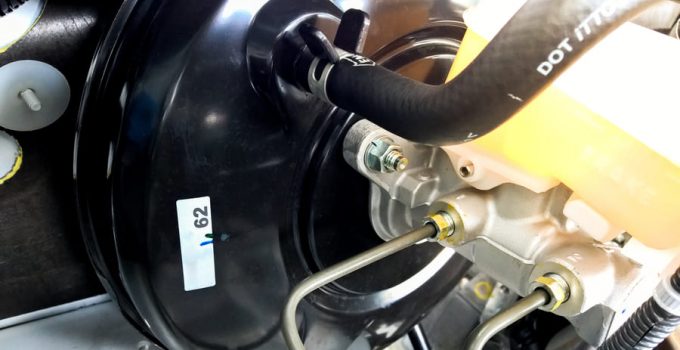
In today's vehicles it is almost impossible to imagine life without it: the brake booster. As every vehicle owner or driver knows, in addition to the correct lighting on the vehicle, as well as intact tires and functional safety systems, a fault-free braking system is also essential. The brakes are the be-all and end-all when it comes to safety, because only the shortest possible braking distance can prevent a traffic accident and the resulting damage to property or even personal injury in dangerous situations. To trigger the braking system, the corresponding brake pedal is pressed. A brake booster thus assists the driver's effort to gradually slow down a vehicle or to brake as abruptly as possible. But how exactly is such a brake booster constructed? How does it work and what are the different types? How to check the functionality of the brake booster? What are the defects and how can they be rectified? We would like to go into all these questions in detail below so that you can get an impression of the brake booster.
Contents
- 1 What types of brake boosters are there?
- 2 How do I determine if the brake booster in working properly in my car?
- 3 Brake booster defects and their symptoms
- 4 Should I repair or replace the defective brake booster?
- 5 What costs should I expect when replacing the brake booster?
- 6 The conclusion and a tip from CarTipsandmore
What types of brake boosters are there?
The two types that are most well-known are the hydraulic brake booster and vacuum brake booster, with most of the today's brake systems in cars have been equipped with a vacuum brake booster.

In petrol engines, there is a vacuum that can be generated by a vacuum pump in the intake tract. The hydraulic brake booster, on the other hand, uses the pressure released by the hydraulic pump, with the motor driving said pump.
How do I determine if the brake booster in working properly in my car?

As we all know, the braking system is one of the most important safety systems your vehicle has to offer. You can only assume maximum safety on the road if the brakes on your vehicle are in perfect working order. Because if the brake booster fails, the driver has to press the brake pedal much harder to get the same effect from the brakes. But how is it possible for you to identify a potential defect in the brake booster? We would like to go into this in detail below.
In order to be able to check the functionality of the brake booster, you should take the following steps carry out:
- First switch off the engine.
- Now you should press the brake pedal several times until you can feel resistance.
- li>Now you should keep the pedal pressed.
- Now start the engine again. If the brake booster is intact, then the brake pedal should give way.
But consider: if you have the impression that the braking effect of your vehicle is decreasing or that the braking distance is increasing, you should definitely visit a workshop, even if the above check of this component has shown a good result. Those skilled in the art know of other ways to test said component. They have the necessary expertise and the right equipment. Be sure to refrain from DIY brake booster diagnostics. Even if you have a sound knowledge of vehicles, when it comes to braking systems, it is still better to let a specialist do the job.
Brake booster defects and their symptoms
There are certain signs that indicate a defect in the brake booster. If any of these signs become noticeable in your vehicle, then you should not hesitate and visit professional specialists in a workshop. But what exactly are these signs?
If you find that the brake pedal does not soften when you start the engine or does not give way at all, then this is an indication of a defect, for example. But even if the brake pedal is as hard to press when the engine is running as it is when the engine is off, this indicates a defect. Have you noticed that braking the vehicle requires more effort or that the braking distance has increased? You can also expect a defect here. A faint hissing noise near the brake pedal is usually not a good sign either.
But consider this: all of these signs are not necessarily symptoms of a fault in the brake booster. Other assemblies, units or systems may be affected as well. Because the vacuum pump or the lines can also have leaks and thus lead to defects. A final diagnosis can usually only be given by a specialist from a workshop.
Should I repair or replace the defective brake booster?
If your brake booster has actually failed or is defective, you shouldn't do things by halves: repairing it is nonsensical and only means a danger to you and other road users. That's why a defective brake booster is simply replaced in a workshop.
In order to replace said component, the specialist will take into account your vehicle model and in any case will completely dismantle the brake lines and the vacuum lines, as well as the master brake cylinder and the brake pedal.
What costs should I expect when replacing the brake booster?
The actual material costs for said component vary greatly, but usually cost up to 300 euros. Since the brake fluid is also replaced, an additional 50 euros must be taken into account here. If now the working hours of the specialists are added – whereby we can assume up to four working hours – the bill for replacing the brake booster can amount to up to 800 euros. But this sum is certainly worth it to be back on the road with a functional braking system.
The conclusion and a tip from CarTipsandmore
Let's be honest: nobody likes to spend three or even four-digit invoice amounts when the vehicle has been taken to the workshop for repairs. But when it comes to road safety, no compromises should be made. A brake booster is an essential component of the braking system in your vehicle. When braking, it amplifies the driver's pedal force so that it can be passed on to the wheel brakes via the master brake cylinder and the brake fluid. A defect in said component can lead to more difficult braking or a longer braking distance. While a braking distance of 3 meters can bring the vehicle to a stop just short of a tree, a braking distance of 5 meters can ensure that the vehicle lands directly in the tree. This is just to make it clear: the length of the braking distance alone can save lives.
CarTipsandmore therefore advises you to have a specialist check the brake booster at every inspection. Only then are you on the safe side and can continue your journey with peace of mind.
